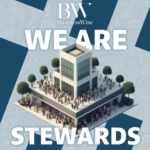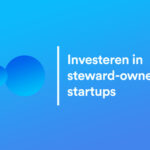
Engelstalige aflevering met Astrid Scholz, ‘zebra’ ondernemer en impact investeerder
In Berlijn, tijdens de Internationale Steward-Ownership Conferentie van onze partner Purpose, had ik, Nina, de kans om impact-investeerder en ondernemer Astrid Scholz te interviewen. Astrid is bekend als een van de auteurs van het manifest “Zebras Fix What Unicorns Break”, dat de startupwereld flink opschudde. Astrid Scholz is een van de drijvende krachten achter alternatieve financieringsvormen in de Verenigde Staten. We gingen in gesprek over durfkapitaal, alternatieve vormen van groeifinanciering en hoe er in de Verenigde Staten tegen ‘zebra’ bedrijven en steward-ownership wordt aangekeken.
Het podcast interview is in het Engels. Onderaan de pagina vind je het transcript.
Astrid is ondernemer en een van de initiatiefnemers van Zebras Unite: een wereldwijde beweging van startende oprichters die niet resoneren met het hypergrowth ‘unicorn’-pad, maar bedrijven bouwen die duurzaam, divers en doelgericht zijn. Deze beweging kreeg grip onder ondernemers en investeerders over de hele wereld, toen de nadelige effecten van het Silicon Valley-model voor groei tegen elke prijs duidelijk werden.
Astrid is tevens oprichter en directeur van XXcelerate Fund, een fonds voor vrouwelijke ondernemers. En fondsen als dit zijn hard nodig, want slechts een fractie, minder dan twee procent (!), van durfkapitaal in de VS gaat naar vrouwelijke oprichters. En nog minder naar vrouwen van kleur. Dat dit systeem op de schop moet, is evident.
“A tiny fraction of venture capital, less than 2%, goes to women founders”
Astrid legt uit waarom het financieringssysteem van Silicon Valley kapot is, hoe het te repareren en hoe nieuwe financierings- en eigendomsstructuren hun weg vinden in de Verenigde Staten: het land van Milton Friedman, Wall Street en shareholder primacy.
Volgens haar zitten veel zogenoemde impact investeerders nog steeds op de gedachte van winstmaximalisatie. Astrid ziet dat als een contradictie: als je echt impact wil maken, moet je als investeerder je ook realiseren dat er in het huidige dominante fundingmodel extractie plaatsvindt.
“A lot of impact investors don’t think rigorously about what it means to be an impact investor. They sort of want to have their cake and eat it too, right?“
Het is daarom belangrijk dat er alternatieve vormen van financiering komen, zoals leningen of ‘capped returns’.
Astrid deelt ook haar visie op durfkapitaal. Hoe gedurfd is het nu echt, om de zoveelste bezorgstartup te funden? Benieuwd? Luister de podcast of lees het transcript onder aan deze pagina (beide in Engels).
Verder lezen
“Zebras Fix What Unicorns Break“: In dit manifest pleiten vier ondernemers voor een ander narratief voor startups. Een die niet gaat over hypergroei, concurrentie kapotmaken en als enige winnaar uit de bus komen, maar een die gaat over bedrijven bouwen die de maatschappij repareren, die divers zijn, langetermijnvisie hebben en gezonde winst realiseren.
Transcript
Nina de Korte (N)
I’m sitting here today next to Astrid Scholz. She is one of the initiators of Zebra’s Unite, and broader: the zebra movement.
Astrid Scholz (A)
Hi, it’s good to be with you.
N: Can you tell me a bit more about the ‘zebra movement’? We all know unicorns, but what is a zebra company?
A: Well, a zebra is a real animal, for starters, and we have adopted it as the mascot for our international movement of founders and investors who are building the businesses that are better for the world. We chose zebras because they’re black and white, profit and purpose. They’re very collaborative animals and they’re feisty. We think of zebra companies as companies that are solving interesting and relevant problems in their communities or in the world. They typically treat their communities as such, not as users that they churn. They tend to take care of their communities and of their workers, and generally have a different approach to building a business that is more sustainable in the long run financially.
They tend to be occupied with actually becoming profitable, as opposed to so many Silicon Valley startups that never turn a profit. Those just create high valuations but never actually produce anything useful. So yeah, those are the origins of the idea of the zebra company.
N: Was this animal born out of your experience, that you and your co-initiators had, in the startup ecosystem in the United States?
A: Yeah, that’s right. All four of us are women tech founders who were building pretty ambitious companies and didn’t get anywhere with venture capital. We decided very quickly that it’s not us, it’s them. What we see in the States: a tiny fraction of venture capital, less than 2%, goes to women founders. It’s even worse if you’re a woman of color, like our friend Aniyia Williams, who’s one of the cofounders. And so we said there’s something very, very broken in the startup system and the funding that’s available for startups. And so we set out to transform it and to create an alternative. It was very much based on our personal experience and Mara Zepeda and Jenn Brendal had written a piece, Sex and Startups, in 2016, which fantastic – it was laugh out loud funny. It was a total send up on all the patterns and mannerisms and norms of the VC world and the startup bro’s. Aniyia and I read it independently – we didn’t know each other at that time. We all were introduced to each other through mutual acquaintances. Very quickly in response to that piece, people were asking, well, what’s the alternative? If it’s not venture capital, if it’s not unicorns, what’s the alternative? And so the four of us sat down in the winter of 2017 to write the alternative, a manifesto. We basically wrote it for ourselves. We wrote about the companies that we were building and called it Zebra fix what unicorns break. And then tens of thousands of people responded saying ‘I am a zebra!’, ‘I want to invest in zebra’s , where do I find more?’ ‘It’s so lonely in Silicon Valley!’ And that was sort of the beginnings of what’s now a movement, a global movement.
N: You were part of the session here before about alternative finance. In that session we spoke about how impact investing is really big right now, it’s getting traction. There’s not enough assets being allocated yet, but it’s growing. It’s a legitimate question: does it make sense if we are trying to do impact investing, if we’re not looking at the underlying structures of the companies we are investing in?
A: No, it does not make sense. I mean, what we find is that a lot of impact investors don’t think rigorously about what it means to be an impact investor. They sort of want to have their cake and eat it too, right? They want to make impact, positive impact in the world with their investments AND get venture style returns. That’s sort of a contradiction. A lot of companies that are solving really difficult social and economic problems are not going to blitzscale like a unicorn, right? If you’re solving for last mile health care delivery in sub-Saharan Africa, you’re not going to have Uber-style growth rates. And you’re not going to build a moat on your market, and all the things that Silicon Valley companies do. So there is this cognitive dissonance among impact investors…What we want them to do more is two things: to reconsider their investment priorities and really think about what their impact return and financial return and risk profile is. It’s really the trifecta, right? It’s not the risk return profile, it’s the risk and impact and return profile. And then match those expectations to appropriate structures that they invest through. If you are trying to make deep impact, you should probably consider grants or low interest loans to enterprises that deliver those impacts and that are likely to be growing more slowly. That’s just a general observation about impact investors. In general, we need more capital that is suited to these novel structures that entrepreneurs are. Creating because they’re driven by purpose, because they align with zebra principles, and who just frankly don’t want to build unicorns, so they should not be accepting unicorn style capital.
N: Right. If we look at steward-ownership, this is a new way or a different way of structuring the ownership of a company. And well, you have experience in the startup world where it’s usually if you fund the startup you become a part owner, sometimes even majority owner. That’s the regular VC route, right? So you have an idea, you pitch it, you raise money and you dilute and dilute. For some founders, this is really all they hear in business schools or in incubators. What is faulty in that narrative? What prompted you to say, hey, let’s redesign this?
A: Well, is it faulty thinking? Isn’t it just legacy thinking?
It’s actually helpful to think back to the early days of venture capital. When you look at the history of venture capital in the early days, it truly was risk capital. They were inventing. Computing didn’t exist, you could not get financing if you were Mr Hewlett or Mr Packard, you could not get financing for these new ideas. It didn’t exist yet in a commercial sense. Lending existed, people were financing projects, of course. People were familiar with doing real estate, or financing banks and railways, newspapers, oil… Industries that the big American fortunes were built on. Those investors were not familiar with new technologies that people were innovating. In the early days, the early venture capitalists called themselves adventure capitalists.
They were really taking big risks because they funded new industries. It was truly risk capital. Early on it became sort of the American way, to say: “oh well, if I’m, if I’m giving you something, you must give me something in return.”
The only thing that an early stage founder had to give was an ownership share. So this attitude became almost cultural, right? I think we then made the connection between risk capital and this demand for ownership in the new company. What’s been happening since, is when you look at venture capital today, they’re no category innovators. There’s a lot of just repeat ideas. Where the risk, right? If I told you today that I’m building a ridesharing company, there’s like 20 gazillion ridesharing companies. So where’s the risk, other than the execution risk? It’s not the same kind of risk – category risk. I think that that’s the faulty thinking. Why is the fact that you’re financing something new immediately tied to ownership? There’s other ways that you can derive a benefit, without ownership. You could just get paid back without having an ownership share. So that’s I think where people went wrong in sort of connecting funding and risk and ownership.
N: Here in Europe, we have a tradition, we call it the Rhineland model (Rijnlandse model). It’s named after the river, the Rhine River.
A: I’m from Cologne, I know all about the Rhine!
N: You’re from Germany, that’s right! Because you and your businesses are based in the US, I forget that you’re German. So here in Europe we tend to involve stakeholders a bit more in businesses and corporations and we pride ourselves in doing that. In the States and the Anglo-Saxon world, shareholder primacy has its roots there, you know, Milton Friedman, etcetera. Does it make the job more difficult? Are the differences greater? Is it easier here in Europe for people to tell why zebra companies or steward-ownership are interesting ideas?
A: Uhm, I’m not sure if it’s harder in the States. You’re right. I mean, culturally, there is a more fertile ground, I think, in Europe. We were just surprised how much the concept resonated in Europe and Asia, and Africa, where they actually have zebras, like literally, the animal! What’s been connecting for people in the States, I think it’s more generational, right? We see millennials and Gen Z moving away from ownership of everything. Ownership of houses, ownership of cars… And so this shifting attitude towards ownership is an interesting one. On the one hand, not needing to own physical assets, but owning your creative assets, right? I think that’s been a generational shift in a really interesting way. And so we’re tapping into some of that. People understand that if they’re creating value, they should have participation in it. And then there are also some very old traditions of mutual aid societies and cooperatives, for example, that are actually deeply rooted in both indigenous society in North America and in the black community, for example. On the one hand you’re working with the youth or the younger generations, and on the other hand you’re tapping into some really old traditions that then converge around notions of “we don’t like status quo because it’s been terrible to indigenous people and to the black population.” And the status quo is also not very advantageous to the young generation who can’t afford anything anymore. The combination, all of a sudden, creates a different kind of fertile ground in the US to say, oh, let’s interrogate our assumptions about entrepreneurship and who owns what and when you’re building a company.
N: So the idea of stewardship is also something that is present in a lot of indigenous communities, for example the 7th generation principle.
A: And generally the idea that we’re interdependent, right? Or the generally the idea that you’re building wealth not just for yourself, but for your community. That resonates with a lot of folks these days.
N: Then my final question…to what problem can steward-ownership be a solution?
A: Steward-ownership, I think, is a solution to two very interesting problems. One, if you’re just starting out as a founder, it basically anchors your values and your vision from the beginning so you never risk dilution. If you structure it from the get-go you create a very clear signal about what your company is about and how it wants to show up in the world. And then one thing I’ve been learning at this conference, is actually fascinating and I’ve sort of known it in the US context a little bit, but it’s really vivid here in Germany in particular. It’s a succession strategy! For family companies and or for founders who are aging out and that’s how it’s been used in the US for example. Organically Grown Company actually, in my home state of Oregon, is an example of that. These founders created this wonderful food distribution company and they didn’t want it to be bought out by some of the behemoths of the, you know, organic food movement. It’s a really potent succession strategy to basically ensure that their values of sharing value with their stakeholders, with the farmers, et cetera, is protected in perpetuity. So those two use cases I think are really interesting: the very early stage founder who’s just thinking about what do I want my company to be when I grow up, and then the founder, or the family, who’s ready to pass on or move on from the company and wants to protect key elements of it.
Nina de Korte: Alright, thank you so much Astrid!
Astrid Scholz: Sure, pleasure talking with you.




